Input interpretation

CuSO_4 copper(II) sulfate + Na_2S sodium sulfide ⟶ Na_2SO_4 sodium sulfate + CuS cupric sulfide
Balanced equation
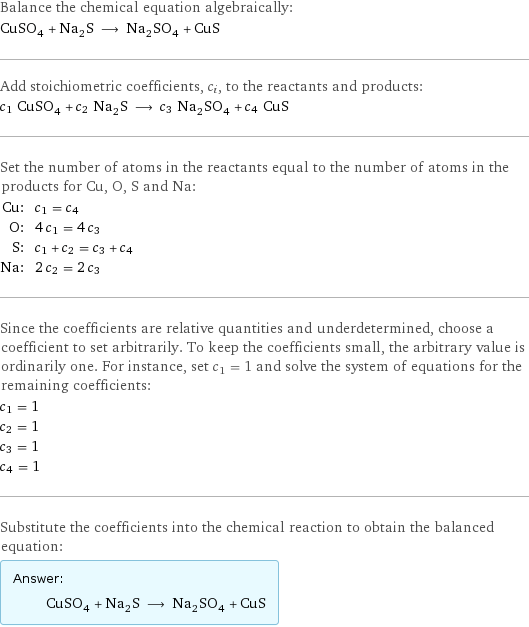
Balance the chemical equation algebraically: CuSO_4 + Na_2S ⟶ Na_2SO_4 + CuS Add stoichiometric coefficients, c_i, to the reactants and products: c_1 CuSO_4 + c_2 Na_2S ⟶ c_3 Na_2SO_4 + c_4 CuS Set the number of atoms in the reactants equal to the number of atoms in the products for Cu, O, S and Na: Cu: | c_1 = c_4 O: | 4 c_1 = 4 c_3 S: | c_1 + c_2 = c_3 + c_4 Na: | 2 c_2 = 2 c_3 Since the coefficients are relative quantities and underdetermined, choose a coefficient to set arbitrarily. To keep the coefficients small, the arbitrary value is ordinarily one. For instance, set c_1 = 1 and solve the system of equations for the remaining coefficients: c_1 = 1 c_2 = 1 c_3 = 1 c_4 = 1 Substitute the coefficients into the chemical reaction to obtain the balanced equation: Answer: | | CuSO_4 + Na_2S ⟶ Na_2SO_4 + CuS
Structures

+ ⟶ +
Names

copper(II) sulfate + sodium sulfide ⟶ sodium sulfate + cupric sulfide
Reaction thermodynamics
Enthalpy
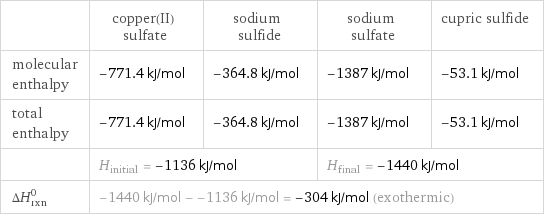
| copper(II) sulfate | sodium sulfide | sodium sulfate | cupric sulfide molecular enthalpy | -771.4 kJ/mol | -364.8 kJ/mol | -1387 kJ/mol | -53.1 kJ/mol total enthalpy | -771.4 kJ/mol | -364.8 kJ/mol | -1387 kJ/mol | -53.1 kJ/mol | H_initial = -1136 kJ/mol | | H_final = -1440 kJ/mol | ΔH_rxn^0 | -1440 kJ/mol - -1136 kJ/mol = -304 kJ/mol (exothermic) | | |
Gibbs free energy
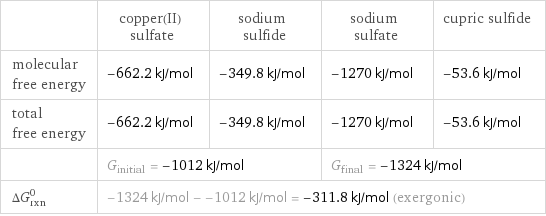
| copper(II) sulfate | sodium sulfide | sodium sulfate | cupric sulfide molecular free energy | -662.2 kJ/mol | -349.8 kJ/mol | -1270 kJ/mol | -53.6 kJ/mol total free energy | -662.2 kJ/mol | -349.8 kJ/mol | -1270 kJ/mol | -53.6 kJ/mol | G_initial = -1012 kJ/mol | | G_final = -1324 kJ/mol | ΔG_rxn^0 | -1324 kJ/mol - -1012 kJ/mol = -311.8 kJ/mol (exergonic) | | |
Equilibrium constant
![Construct the equilibrium constant, K, expression for: CuSO_4 + Na_2S ⟶ Na_2SO_4 + CuS Plan: • Balance the chemical equation. • Determine the stoichiometric numbers. • Assemble the activity expression for each chemical species. • Use the activity expressions to build the equilibrium constant expression. Write the balanced chemical equation: CuSO_4 + Na_2S ⟶ Na_2SO_4 + CuS Assign stoichiometric numbers, ν_i, using the stoichiometric coefficients, c_i, from the balanced chemical equation in the following manner: ν_i = -c_i for reactants and ν_i = c_i for products: chemical species | c_i | ν_i CuSO_4 | 1 | -1 Na_2S | 1 | -1 Na_2SO_4 | 1 | 1 CuS | 1 | 1 Assemble the activity expressions accounting for the state of matter and ν_i: chemical species | c_i | ν_i | activity expression CuSO_4 | 1 | -1 | ([CuSO4])^(-1) Na_2S | 1 | -1 | ([Na2S])^(-1) Na_2SO_4 | 1 | 1 | [Na2SO4] CuS | 1 | 1 | [CuS] The equilibrium constant symbol in the concentration basis is: K_c Mulitply the activity expressions to arrive at the K_c expression: Answer: | | K_c = ([CuSO4])^(-1) ([Na2S])^(-1) [Na2SO4] [CuS] = ([Na2SO4] [CuS])/([CuSO4] [Na2S])](../image_source/75640bcd79f9bc0a97babbc3fc3cf410.png)
Construct the equilibrium constant, K, expression for: CuSO_4 + Na_2S ⟶ Na_2SO_4 + CuS Plan: • Balance the chemical equation. • Determine the stoichiometric numbers. • Assemble the activity expression for each chemical species. • Use the activity expressions to build the equilibrium constant expression. Write the balanced chemical equation: CuSO_4 + Na_2S ⟶ Na_2SO_4 + CuS Assign stoichiometric numbers, ν_i, using the stoichiometric coefficients, c_i, from the balanced chemical equation in the following manner: ν_i = -c_i for reactants and ν_i = c_i for products: chemical species | c_i | ν_i CuSO_4 | 1 | -1 Na_2S | 1 | -1 Na_2SO_4 | 1 | 1 CuS | 1 | 1 Assemble the activity expressions accounting for the state of matter and ν_i: chemical species | c_i | ν_i | activity expression CuSO_4 | 1 | -1 | ([CuSO4])^(-1) Na_2S | 1 | -1 | ([Na2S])^(-1) Na_2SO_4 | 1 | 1 | [Na2SO4] CuS | 1 | 1 | [CuS] The equilibrium constant symbol in the concentration basis is: K_c Mulitply the activity expressions to arrive at the K_c expression: Answer: | | K_c = ([CuSO4])^(-1) ([Na2S])^(-1) [Na2SO4] [CuS] = ([Na2SO4] [CuS])/([CuSO4] [Na2S])
Rate of reaction
![Construct the rate of reaction expression for: CuSO_4 + Na_2S ⟶ Na_2SO_4 + CuS Plan: • Balance the chemical equation. • Determine the stoichiometric numbers. • Assemble the rate term for each chemical species. • Write the rate of reaction expression. Write the balanced chemical equation: CuSO_4 + Na_2S ⟶ Na_2SO_4 + CuS Assign stoichiometric numbers, ν_i, using the stoichiometric coefficients, c_i, from the balanced chemical equation in the following manner: ν_i = -c_i for reactants and ν_i = c_i for products: chemical species | c_i | ν_i CuSO_4 | 1 | -1 Na_2S | 1 | -1 Na_2SO_4 | 1 | 1 CuS | 1 | 1 The rate term for each chemical species, B_i, is 1/ν_i(Δ[B_i])/(Δt) where [B_i] is the amount concentration and t is time: chemical species | c_i | ν_i | rate term CuSO_4 | 1 | -1 | -(Δ[CuSO4])/(Δt) Na_2S | 1 | -1 | -(Δ[Na2S])/(Δt) Na_2SO_4 | 1 | 1 | (Δ[Na2SO4])/(Δt) CuS | 1 | 1 | (Δ[CuS])/(Δt) (for infinitesimal rate of change, replace Δ with d) Set the rate terms equal to each other to arrive at the rate expression: Answer: | | rate = -(Δ[CuSO4])/(Δt) = -(Δ[Na2S])/(Δt) = (Δ[Na2SO4])/(Δt) = (Δ[CuS])/(Δt) (assuming constant volume and no accumulation of intermediates or side products)](../image_source/d40c8f2c0baad7b1060e163612672522.png)
Construct the rate of reaction expression for: CuSO_4 + Na_2S ⟶ Na_2SO_4 + CuS Plan: • Balance the chemical equation. • Determine the stoichiometric numbers. • Assemble the rate term for each chemical species. • Write the rate of reaction expression. Write the balanced chemical equation: CuSO_4 + Na_2S ⟶ Na_2SO_4 + CuS Assign stoichiometric numbers, ν_i, using the stoichiometric coefficients, c_i, from the balanced chemical equation in the following manner: ν_i = -c_i for reactants and ν_i = c_i for products: chemical species | c_i | ν_i CuSO_4 | 1 | -1 Na_2S | 1 | -1 Na_2SO_4 | 1 | 1 CuS | 1 | 1 The rate term for each chemical species, B_i, is 1/ν_i(Δ[B_i])/(Δt) where [B_i] is the amount concentration and t is time: chemical species | c_i | ν_i | rate term CuSO_4 | 1 | -1 | -(Δ[CuSO4])/(Δt) Na_2S | 1 | -1 | -(Δ[Na2S])/(Δt) Na_2SO_4 | 1 | 1 | (Δ[Na2SO4])/(Δt) CuS | 1 | 1 | (Δ[CuS])/(Δt) (for infinitesimal rate of change, replace Δ with d) Set the rate terms equal to each other to arrive at the rate expression: Answer: | | rate = -(Δ[CuSO4])/(Δt) = -(Δ[Na2S])/(Δt) = (Δ[Na2SO4])/(Δt) = (Δ[CuS])/(Δt) (assuming constant volume and no accumulation of intermediates or side products)
Chemical names and formulas
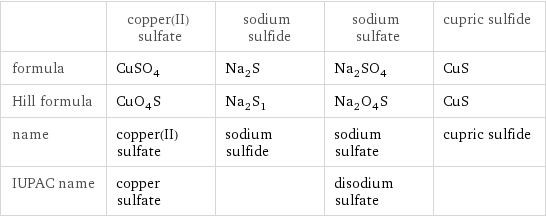
| copper(II) sulfate | sodium sulfide | sodium sulfate | cupric sulfide formula | CuSO_4 | Na_2S | Na_2SO_4 | CuS Hill formula | CuO_4S | Na_2S_1 | Na_2O_4S | CuS name | copper(II) sulfate | sodium sulfide | sodium sulfate | cupric sulfide IUPAC name | copper sulfate | | disodium sulfate |
Substance properties
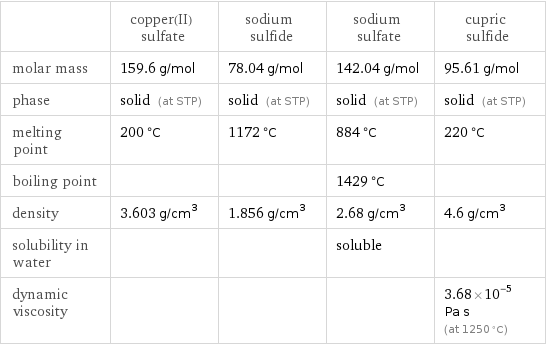
| copper(II) sulfate | sodium sulfide | sodium sulfate | cupric sulfide molar mass | 159.6 g/mol | 78.04 g/mol | 142.04 g/mol | 95.61 g/mol phase | solid (at STP) | solid (at STP) | solid (at STP) | solid (at STP) melting point | 200 °C | 1172 °C | 884 °C | 220 °C boiling point | | | 1429 °C | density | 3.603 g/cm^3 | 1.856 g/cm^3 | 2.68 g/cm^3 | 4.6 g/cm^3 solubility in water | | | soluble | dynamic viscosity | | | | 3.68×10^-5 Pa s (at 1250 °C)
Units
